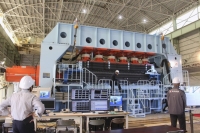The National Research Institute for Earth Science and Disaster Resilience on Tuesday showed the media an earthquake simulation test using a state-of-the-art test machine.
The institute hopes that the machine will help uncover the mechanism of earthquakes in a natural setting in order to predict large quakes such as ones forecast to occur in the Nankai Trough, which runs off the Pacific coast of central to southwestern Japan.
The machine, said to be the world's largest, weighs about 200 tons and consists of two stacked rock slabs, one 7.5 meters long and the other 6 meters long. It uses hydraulic jacks to apply force to the upper and side surfaces of the two rocks to rub them against each other, thereby replicating the sliding of faults.
It was completed in August at a cost of about ¥400 million, according to the institute in Tsukuba, Ibaraki Prefecture.
In Tuesday's experiment, about 300 tons of force was applied from the top and about 120 tons from the side of the stacked rocks, reproducing about 100 slides as the rocks moved against each other by a centimeter.
In a Nankai Trough quake scenario, which is expected to cause severe damage, a temblor with a magnitude of around 8 occurring in the eastern or western side of the expected focal region is said to be highly likely to trigger another huge quake elsewhere in the region.
By using the machine to simulate realistic quakes, the institute hopes to gain a better understanding of the mechanism behind quakes and their chain reactions.
"We want to use the knowledge obtained from the simulations for earthquake prediction research," said Futoshi Yamashita, a senior researcher involved in the development of the machine.




